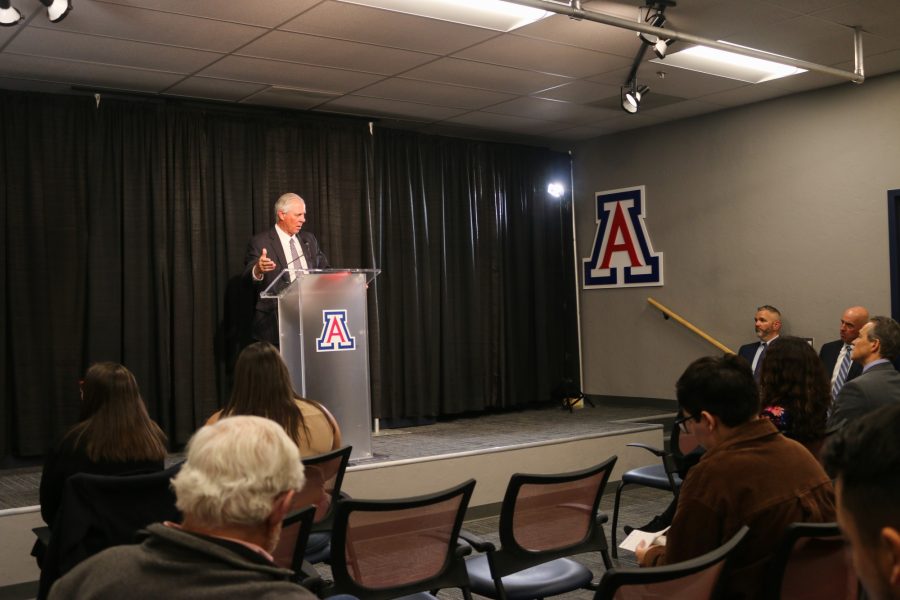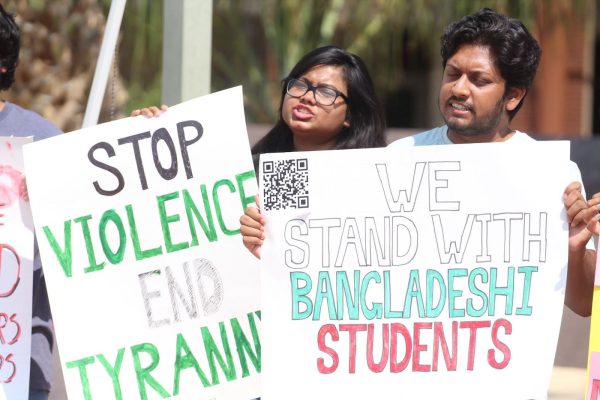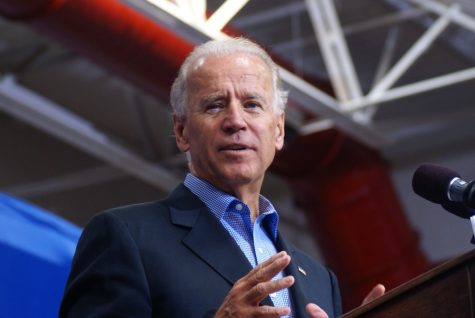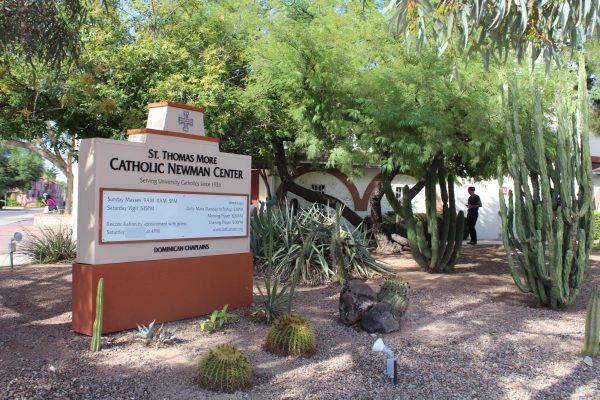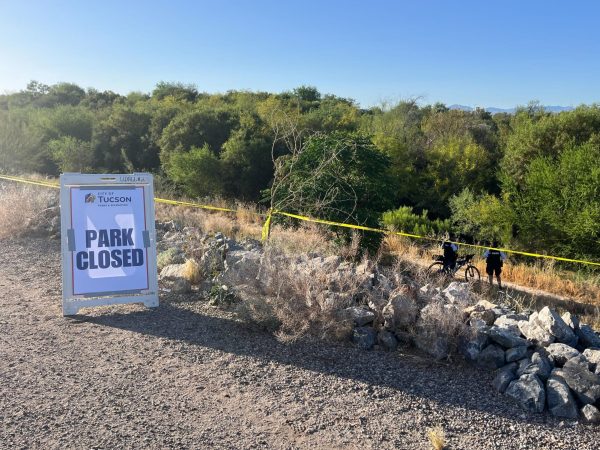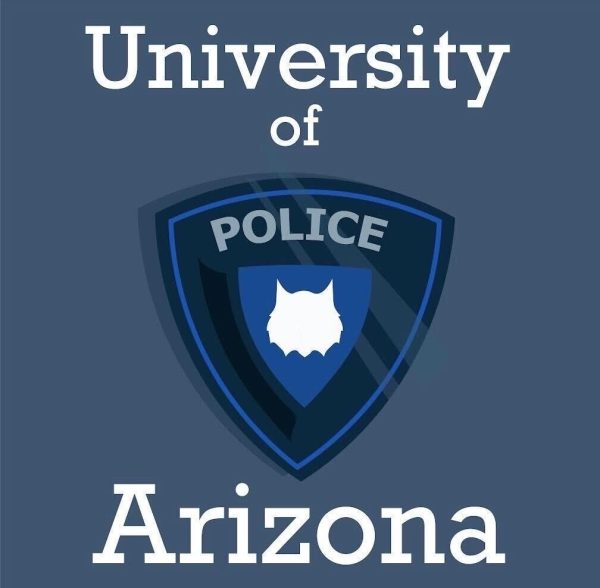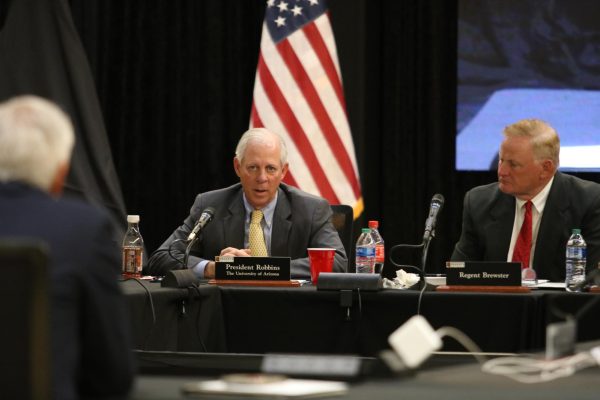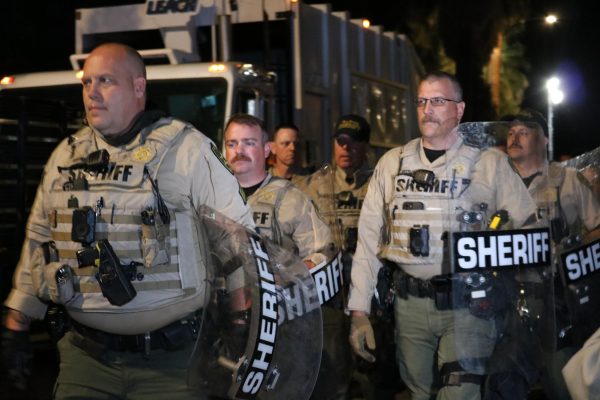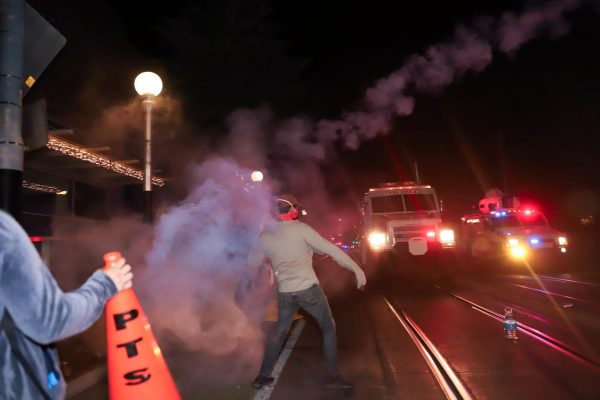UA president addresses newly released, long-awaited report on campus safety failures
President Dr. Robert C. Robbins speaking at a press conference on March 27 regarding the release of the PAX safety report. The report outlines the institutional issues and safety concerns at the University of Arizona that led to the Oct. 5 shooting of hydrology professor Thomas Meixner.
March 28, 2023
The University of Arizona released the promised campus safety and security report Monday, March 27, analyzing major areas of systemic failure in the school’s handling of the fatal shooting of professor Thomas Meixner.
UA President Dr. Robert C. Robbins held a press conference that afternoon to address the report and answer media questions.
The document, over three months past due from the initial deadline reported by Robbins, details four main areas where the UA needs improvement when it comes to crisis management and lists 33 recommendations on how the school can improve.
“I am angry at myself that I did not do more to prevent this tragedy,” Robbins said at Monday’s press conference. “I’m determined to honor Tom Meixner’s legacy by making any and all necessary changes to keep our campus safer […]. The UA is already safer than it was in October. Once all the recommendations have been implemented, we will be even safer.”
Ineffective procedures
As the report notes, while the Oct. 5, 2022 shooting was “shocking and disturbing, it was not unforeseeable.” In fact, PAX Group, the security consulting firm that created the analysis, highlighted three overall concerning themes reflected in the UA’s crisis management, including “understanding and managing threat.”
Several members of the UA’s Department of Hydrology and Atmospheric Sciences, including Meixner, reported harassment from alleged shooter Murad Dervish for months leading up to the incident.
The report also lists three specific moments when the UA Police Department and the Threat Assessment Management Team could have intervened with Dervish, including a February 2022 incident where he was seen on campus in violation of his expulsion.
“I think, for the most part, we do a fairly good job of identifying who [people banned from campus] are and either arrest them or ask them to leave the campus,” Robbins said Monday.
A list of people banned from the UA campus can be found on the UAPD website, though Robbins said this case was “different” than most exclusionary orders in that it was more personal.
From analyzing actions taken by UAPD, or lack thereof, the report found that “UAPD tended to leave the decision on ‘next steps’ to faculty, staff, or students,” but “most often, charges were not intended to be filed by these individuals out of fear of retaliation.”
Robbins said he hopes revamping the ineffective TAMT, as the report suggests, will help improve the school’s ability to identify and manage threats.
The TAMT website lists 10 current members, including UA Chief of Police Paula Balafas and three other UAPD leaders.
Despite recognizing TAMT’s and UAPD’s failures, Robbins expressed confidence in this leadership.
“I think, going forward, we’re going to work on what we need to do to better follow policies and procedures around who we can arrest, when we can arrest them, how we can get charges actually filed,” Robins said Monday. “I think that there’s clearly a lot of room [and] opportunity for improvement.”
Accountability
According to Robbins, the lack of communication — one of the four areas the report suggests improvement in — and FERPA concerns in regards to Dervish, played a huge part in the handling of the events leading up to the shooting.
“I think out of an abundance of caution, there was a reluctance to share information with other departments or other individuals, because of these privacy concerns,” Robbins said Monday.
He also said he should be held accountable for everything that goes on at the UA, though the report lists systemic failures found within specific departments.
“There are going to be many detailed and very difficult conversations that’ll have to be had in the coming weeks to months,” Robbins said at the conference. “I can’t comment on personnel issues publicly, but we’ll be doing a lot of soul searching and looking at all the data and the actions that were taken.”
An apology
Another overall theme the UA failed in, according to the report, was “providing a consistent, empathetic, and compassionate response.”
A lack of compassion from the UA was also noted by the faculty committee who were tasked with reviewing the UA’s crisis management and compiling community perspectives on campus safety and concerns.
At Monday’s press conference, Robbins said he apologized for criticizing the faculty committee’s report, titled “Oversight and Response Failure: Broken Trust. Lessons From the Events Surrounding the Murder of Professor Thomas Meixner.”
After the faculty report was released in February, a public statement from the UA claimed the committee made “sweeping conclusions based in large part on misleading characterizations and the selective use of facts and quotes.”
Shortly after, the committee released a resignation letter addressing both the feedback from the administration and the fears of retaliation amongst the members, noting the UA’s leadership had “displayed an unhealthy attitude toward safety and organizational culture.”
The letter also said the university declined to address which parts of the faculty report were allegedly untrue.
“I regret that we sent out that statement criticizing the faculty,” Robbins said Monday. “All they were trying to do was to bring awareness of what we need to have a safer campus. And I focused too much on the details and not the big picture of just waiting for the PAX report.”
Moving forward
The UA has begun working toward implementing the PAX Group’s recommendations, according to Monday’s email from Robbins to the school’s community.
One update includes automatically enrolling all students, staff and faculty into the UAlert system.
A month before the campus shooting, members of the Associated Students of the University of Arizona, the school’s student government, discussed UAlert’s ineffectiveness in a separate incident involving reports of an armed gunman on campus near the Student Union Memorial Center.
At Monday’s press conference, Robbins said the school is looking into alternative or additional emergency alert systems after many members of the UA community called on the UAlert system to be replaced altogether.
An upcoming change to the UA’s crisis management includes the installment of retired FBI agent Steve Patterson as the Interim Chief Safety Officer starting May 1.
Patterson, who has been assisting the school since November 2022, will be responsible for “implementing the PAX Group’s recommendations and coordinating safety initiatives across” the UA while the search for someone to take over begins, according to Monday’s email.
The PAX Group’s full safety and security report can be found on the UA’s main website at arizona.edu/issues.
Stay tuned with the Daily Wildcat for a deeper look at the report.
Follow JT Thorpe on Twitter



